Mako "Things I Like": 2022
The annual Mako “Things I Like” report for 2022.
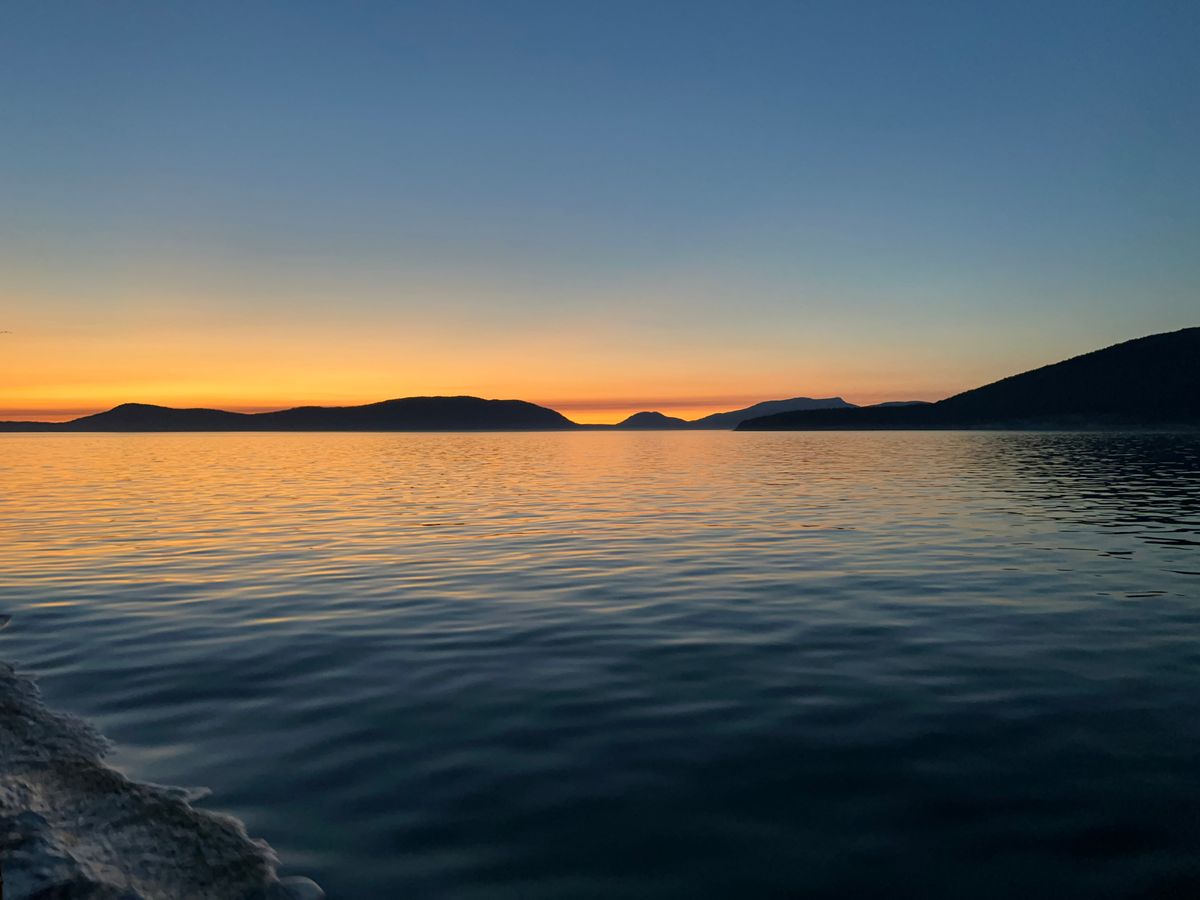
This is the 8th annual big ass post (err, tradition?) to keep track of and share out the things/apps/processes/musings that I have found helpful throughout the year. Think of it as my own micro "yearly review" with links and tips for the things I surround myself with as part of an ongoing attempt to maximize my daily workflow, put me in the zone, and elicit happiness.
2022 Reflection
When I look back at the end of 2021, I had talked about shifting my focus - it was less about the work but the process of doing the work. And while 2022 continued down that thematically, I've been spending more and more time reflecting on life in general.
Perhaps it's the crossing of the Brimley Line or trying to get my mental health back in alignment with the realities of what my body has been through. Surviving two heart attacks before the age of 50 (one being a 90% blockage of the LAD, aka the 'widow maker') along with heart surgery to treat atrial fibrillation wasn't on my life-bingo card. I've certainly faced my mortality more than I expected, and I've been struggling a bit this year coming to terms with the idea that I can't do the same types of endurance activities that I used to enjoy.
Instead of focusing on what I can't do, I'm trying hard to shift my goals into things I can: taking long walks, stationary cycling, and shorter runs. Moving from "I can no longer" to "I get to" is a critical mind shift to embrace.
Like everyone, I have those days when I quickly fall back into old, stressful habits. Establishing a better sense of control often comes down to how I spend time and who I spend that time with. Some days, it is a struggle to focus on the things within my control and just let go of the things that aren't. It's not easy; it's pretty tricky, and I have yet to figure it out completely. But I'm trying hard daily to recognize those patterns and shift focus when I do.
The most significant insight I've come to understand is that it's okay to acknowledge these feelings and that some days aren't perfect.
What you do with them is what matters.
Never waste energy on worries or negative thoughts. All problems are brought into existence - drop them. - Bruce Lee
So that's where I am, wrapping up 2022 - trying to understand myself better and not investing time on the negative. Be like water.
Going to wrap this one up (as there's a lot more to read below), but this magnificent post, Three Thoughts: Energy, Friendship, & Perception resonated. Here are a few excerpts from it:
1. Your healing creates waves that are consciously and unconsciously felt by others. The vibration or energy that you emit reverberates outward and influences the environment and those in it.
2. The reality is that friendships take work. You need to put energy into your friendships to keep them alive and well nourished, similar to tending a garden. A connection needs both people to feed it intentionally for it to remain healthy.
3. Being able to see yourself as you are moving through your own emotional spectrum is an essential quality to cultivate. Knowing the difference between who you are when you are balanced versus who you are when your mood is low can help you go through tough moments without making them harder than they already are. Noticing when you are in a low mood should make you question the assessments and judgments you are making. You know from past experience that heavy emotions negatively color your view.
A fantastic read to shift the mindset to end the year.
I hope you enjoy this year's update and that you are well heading into 2023.✌🏻
If you enjoy these posts, you can buy me a coffee ☕️, or if you'd rather keep up with my daily ramblings, follow me on Mastodon, Twitter, or keep reading my posts on this blog.
2023 Mantra
Last year, I attempted to cast forward a 'mantra,' which was 'I take one step, then another, then another'.
2023's mantra is: One year is 365 possibilities: make progress.
Makoism "Deep Links"
Back in early 2020, I restarted my old blog (the artist formerly known as "The Furrygoat Experience") as a way to keep a few peers, friends, and colleagues, engaging on content that I had discovered online weekly.
The result was unexpected but incredibly encouraging: people enjoyed it (all 450 of you)! What's humbling is that I'm consistently seeing 60-65% opening and reading my weekly ramblings on leadership, storytelling, life, and humor. THANK YOU.
Makoism.com has been incredibly rewarding for my mental health - a bit of self-therapy if you will - continuing the daily practice of reading and writing. The connections I've been strengthening from the simple approach of putting it out there, talking bluntly, and focusing on things that I found interesting have been enriching.
I am always happy to connect (here's a link on LinkedIn), so feel free to reach out! And if someone forwarded this to you, subscribe (free!) to get my posts on this weekly.
Here is a list of the top articles in case you missed them:
- How to win the week with a Weekly Review
- Psychology Reveals 10 Behaviors of Cynical People
- Shields Down
- The Kaizen Way
- How to Play Better Games in the Metagame of Life
From my posts, these have been the most popular over the last year:
- Facing the Struggle
- With Constraint Find Freedom
- You're Solving the Wrong Problems
- Maybe They're Just an Asshole
- Own Your Shit
I've also found it amusing that people have been requesting "Own Your Shit" shirts - maybe that's something I'll venture into next year. 🤪
The Purge (Annual Audit)
One of the most useful annual undertakings is the personal technology audit. When I talk about audits, this isn't about the apps I am using that are sitting there collecting dust, but taking a hard, honest look at playlists, subscriptions, tools, and workflow in the entire ecosystem that encompasses my day-to-day computing devices and workflow.
The basic outline of the purge that I have used and continue to find useful:
- Apps — examine the apps on your phone, iPad, and laptop . Have you used the app in the last two months? If not, you don't need it. Delete it.
- Media — do you need all those documents/movies/music on your phone or laptop with you? With streaming, wireless and clouds today, do you need 24,000 songs, 19 movies, and every receipt with you? If not, storing things in iCloud, Google or Amazon helps keep my devices light.
- Subscriptions — ask yourself: are you getting value out of that application subscription? If not, cancel it. My litmus test is if it's a service (media, storage where they are paying costs for hosting, etc.), I will pay to help keep it going. If an app I love has a "lifetime" option, such as Flighty, I'll buy that. Apps are in a weird phase right now — It's getting harder and harder to avoid subscriptions, and I don't mind annual upgrade charges. I cannot handle being nickel and dimed monthly, though.
- Higher Learning — Do you have time to write in your journal daily? Do you have a few hours aside a week for learning? Do you read enough? I make time to journal entry in DayOne every day — even if it's a sentence.
- On the day-to-day — what is the best way to manage your day, get through your to-do list, deal with the landslide of email, and optimize reading for the most impactful content? See my post on Flow to learn more about thirty minutes of daily reading, writing, and playing.
This year's most significant change was around the areas of personal knowledge management. (Nice segue!)
It's been over a year since I have gone with a complete separation of work from my devices. The goal was to create rigid boundaries for myself to block bad habits: no more Slack, Teams, work calendars, and work email on my machines outside of the one provided by my employer.
What a difference this has made. I recently explained this to a colleague, and they almost couldn't wrap their heads around the separation.
The conversation we had at a recent tech conference (I didn't have my laptop with me) went something along the lines of:
Co-worker: "I'm going to send you that meeting for later."
Me: "I don't have work on my cell phone."
Blank stare. 5 seconds. 10 seconds.
Co-worker: "Huh!? What? Do you have a work phone?"
Me: "Nope."
Blank stare. 5 seconds. 10 seconds.
Me: "When you need me, how do you reach me?"
Co-worker: "I send text... email is terrible".
Me: "Yup."
Blank stare. "Holy shit. That's brilliant".
Maybe not brilliant, but it's effective.
Through the year, I have also continued the "trusted trio" method for dealing with inbound mail and folders:
- Follow-up — this is for emails that represent a quick action that involves a human; this often ends up being another type of follow-up in Things and is one I don't use often.
- Hold — a temporary holding area; I mainly used this to keep online order confirmation emails until I physically received them (and then moved to archive).
- Archive — pretty self-explanatory; it was the old "annual" folder for everything else if it doesn't fall into a particular category.
I am still planning on purging the "archive" folder to backup to start the new year with a clean slate.
Flow
I've always been proud of the habit of Inbox Zero, responding to messages quickly; I've started to take a more critical lens to it this year. There's something to the argument that "everything in life is an inbox" (which is a great article to read if you haven't), and I can certainly relate to sometimes letting things stew is better than just responding.
But the idea that email is not my task list is essential, so here are some excellent tips on discovering how liberating this can be.
My flow is pretty straightforward for every new mail:
- If I don't need it and can delete it, I delete it immediately.
- If it's something that I can answer immediately, I do. Then the Email goes into the 'archive, hold, or followup' folder or deleted. The 2022 addition here: sometimes let it stew, but move it out of the Inbox.
- If the Email was a link to an article, a video, a podcast, or whatever else I can consume later, it quickly goes into Reeder.
- If it's something that I need for information later, it quickly goes into the 'archive' folder. Then it is deleted.
- If it's something that I need to think about or take action on, it quickly goes over to Things as a to-do item, with tags, a project, and a due date. Then the Email goes into the 'archive' folder or deleted.
The process is quick and straightforward, and my Inbox never becomes a dumping ground for tasks.
Calendar Management
(From "It's About Time" and "Don't Do It")
We all have those terrible Tetris-looking work calendars; in fact, I exported my meeting list from 2022 and found that almost 71% of my working hours, were spent in a meeting this year. It's staggering and something I need to continue to improve in 2023.
While I've strived to have a more deliberate focus on my calendar (with various levels of success), here's the methodology I've been toying with and need to refine further into next year:
- Use categories with calendars; green is "calendar management," dark gray is "cannot move" (a doctors appointment), yellow is "open office hours," etc
- Set core working hours. 9 am-5 pm PST, for example.
- Block out the calendar outside of core working hours. I use "CM" for 'calendar management,' for example, "CM: Leave me alone."
- 30 minutes at noon for lunch, I block (in green), "CM: Lunch"
- Friday afternoons, from 1 pm-5 pm, I block (in green) "CM: Focus Friday" - I want time at the end of the week to focus, read, wrap up the week, learn a new thing, etc. I've also extended this block to my entire organization - a deposit in the collective "time bank."
- One day a week, I also have a block of "open office hours" - feel free to schedule a catch-up; let's chat about random shit, but I know I'll be interrupted.
- Now that I have the general week blocked out, each day I also pick a 2-hour block as "CM: Think (but flexible)" - these are movable, complete-time blocks if a meeting pops up, but it also ensures I have a solid 2-hour continuous block to be productive and in 'the flow.'
Just remember: Time is currency. Your calendar is a bank. Make deposits and withdrawals carefully.
The Anti-PKM
(From: "Circling the Drain")
Last year I talked about a "Second Brain". This year, two ideas stuck with me.
First is The Fall of Roam:
After some time, though, reality started to sink in. 'I am not really going back through all of these notes as often as I thought I would.' My next automatic assumption is that if they were just organized better I might go through them more. And so, the question starts to creep in again. 'Where should I put this?'
And, Notes apps are where ideas go to die.:
You think of something, write it down, and feel free. Find something else, bookmark it, and close the tab without worry. If you need that discovery again, it's only a few taps away. The placebo effect—or, at least, the new app effect—is real.
By letting go, you've cleared up space for new quests. No more dozens of tabs open forever; you saved them, then let them go back into the ether. No perpetual thinking on an idea; you wrote it down, let your second brain remember for you.
Then we're free. We've stalked the prey, secured it for later nourishment. We can safely forget. We've insured against faulty memories. Now on to the next quest, finding something new to stash.
That's the true value of notebooks, notes apps, bookmarking tools, and everything else built to help us remember. They're insurance for ideas. They let us forget.
So that's where I am - I've dumped a lot of my process for idea collection and long-term storage. I use simple tools now:
- Reeder 5 is where I store most things now - articles, videos I want to watch, and things to catch up on. It is my primary "read it later" app.
- Apple Notes is where I store everything I want long-term. I don't need crazy note wiki links or robust interconnected PKM madness; just take a note and hold it for "long term memory."
Simplicity equals Freedom.
New for 2022: Contextual Computing
What initially started as playing around with the basic functionality of Focus Mode on the Mac and iOS has led me down a path of some fascinating exploration around a different type of computing.
I lump this thinking into Contextual Computing.
The general onus behind contextual computing isn't new:
it's used to refer to the use of computer technology to collect and analyze data about its own surroundings. The idea is to create devices which are aware of their surroundings and which can analyze the data to come up with exciting new use cases.
But the idea of using your surroundings and current "context" for your actions is becoming more and more natural with the sensors in phones and (in my case) the Apple Watch.
For example - when I go to sleep, I have my watch face dynamically change to a new one that provides me a different type of display that gives me more relevant information.
- The face shifts to a dark red hue, so it doesn't wake me at night.
- The face changes to Modular, with the following apps: Heart Analyzer (Recent HR, SPO2, HRV), AutoSleep (Status), and the built-in apps to give me other heart-related information.
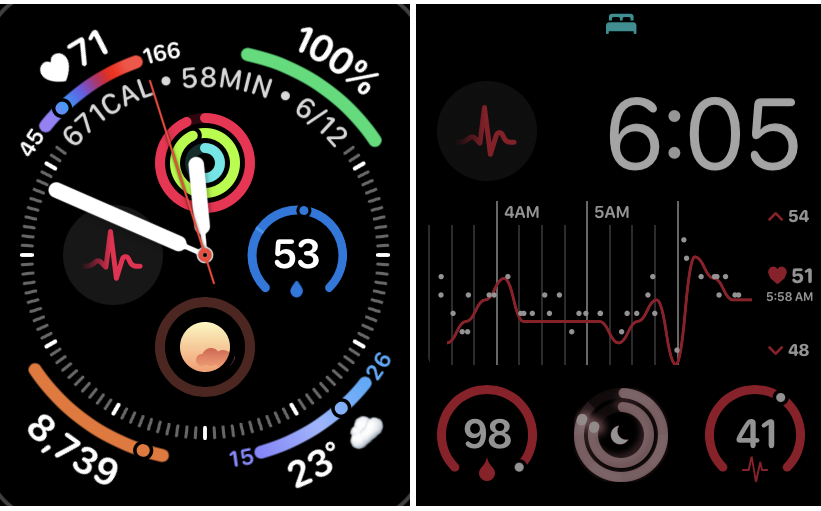
If you're wondering how I have it automatically change the watch face itself via Focus:
- On your iPhone, go to Settings > Focus.
- Tap Set Up next to a Focus or create a new Focus, tap Customize Focus, then tap Choose below the Apple Watch image.
- Select a watch face, then tap Done.
Easy! Check out this relevant article on how others have used Focus mode.
I'm planning on playing even more with this idea next year - I want to start using apps like Just Press Record to create a "Walking" context focus. Imagine having to leave the phone behind, talk to the watch via the AirPods, and have it auto-transcribe into a note when I return home.
So yes - Content may be King, But Context is Queen & She Holds the Purse Strings.
The 2022 Desk Setup
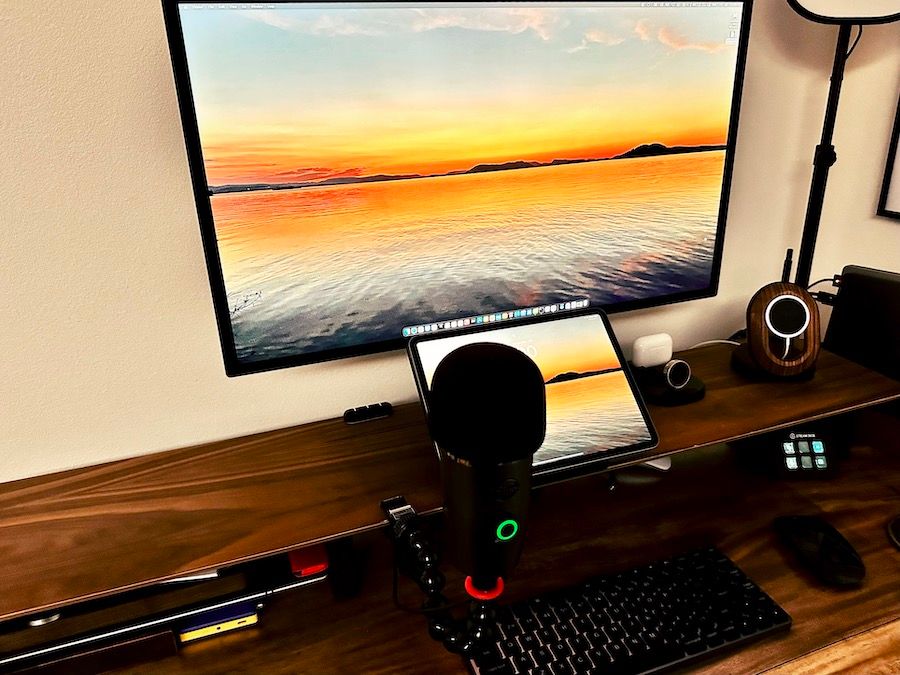
Here's where my setup lands ending in 2022:
- MacBook (Air 512GB/24GB, M2, Space Gray) — I am on this laptop all day long in my home office. I love it.
- iPhone 14 Pro (512GB, Space Gray) — Goes with me everywhere.
- iPad Mini 6 (512GB, Space Gray) — I was so happy that this device was finally released. It's my favorite around-the-house device, but I am testing a bit of the same configuration now with an M2 iPad Pro 11.5" for the extra screen room (and trying to save my old eyes).
- Apple Watch Ultra — Wowzers; I didn't expect this one to be an essential piece of new tech for my health in 2022. Here's more on how I've used the watch for my health tracking.
- MB Pro 14" — the work laptop. Now that I'm on Apple Silicon for work, it's not as bad as the crappy old Intel MBP 13" I had, but this is what I lovingly refer to as the work brick.
I have an ancient Mac Mini media server that is used to archive content and back up the Synology NAS to Backblaze.
Other random gear:
- AirPods Pro 2 — these are my primary headphones for calls, and the old AirPod Pro "original" are my backups.
- Vissles LP85 Keyboard - basically, a mechanical Apple Keyboard; but offers some great features like multi-computer support. While I occasionally use the Magic Keyboard, I wanted to play more into mechanicals this year.
- Oakywood Dual Laptop Vertical Stand - I keep both the work and home laptop in this, so they're out of the way.
- 2 in-1 Wireless Watch Charger Portable Charging Stand - its just cleaner than having cables everywhere.
- AirPod Max - I know, the case is stupid. But the sound quality on these is fantastic for listening to music and watching movies.
- AirPod Max Waterfield Case - I am waiting for these to arrive; as mentioned, the AirPod Max "bra" case is terrible.
- Grovemade MagSafe Stand
- Blue Yeti Nano and Blue Yeti Compass
- Apple Studio Display
- Grovemade Desk Shelf
- Grovemade Pen and Stand
- Pete's Pirate Gear — candle, challenge coin and dice. Yo ho yo ho.
Camera Setup
Since I spend a ton of time in virtual meetings, I found it humorous how often others ask me about the camera setup. I can't stress how important getting good lights and a proper camera changes things for the day-to-day when video calls are the bulk of where you put in the time.
EDC
A few changes since my 2021 clean up the EDC'.
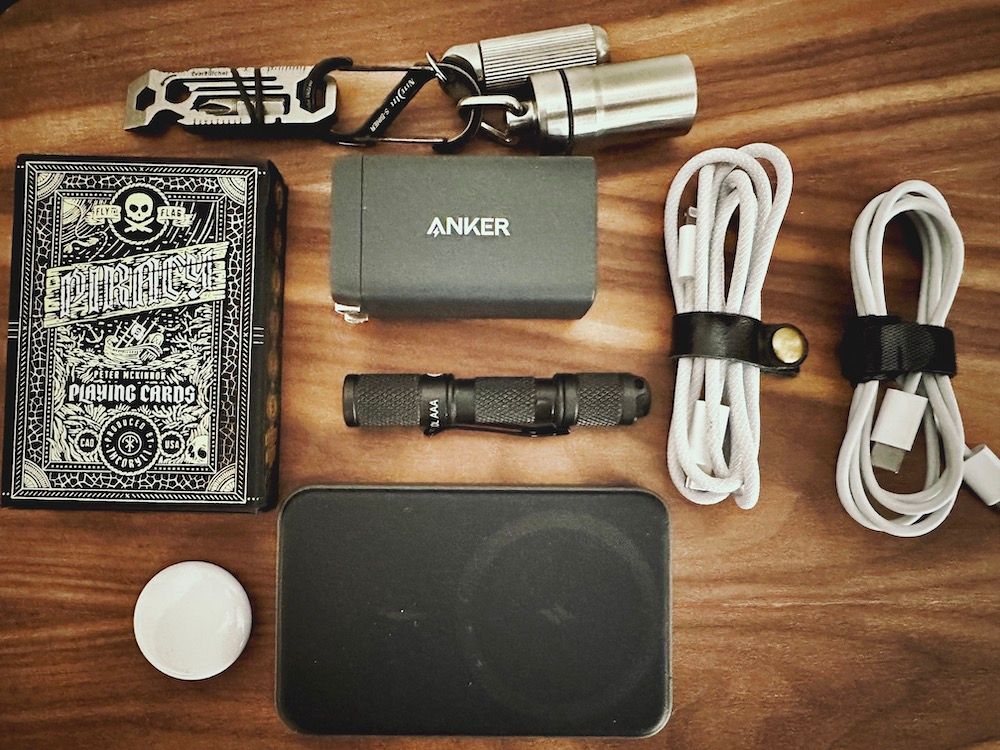
Here's the shopping list:
- Nite Ize S-Biner Dual Carabiner — to clip on water-proof pill containers (this one and this one) to bring heart medication everywhere. Unfortunately needed these days.
- Anker 622 MagGo Battery — a small/light battery that doesn't need a cable to charge the phone. Also, nice that it can use the USB-C to charge (plug in the Satechi watch/AirPods charger into it).
- USB-C to USB-C and USB-C to Lightening charge cables.
- Leather cable straps — because they are functional and look fantastic.
- Anker USB C 735 Charger — a 65w, ultra-fast two-port USB-C and 1 USB-A charger that is small, can quickly charge a laptop, iPad, etc. and is the only charger you'll need. My overnight bag has the Anker 747 Charger GaNPrime 150W 4-port version.
- EverRatchet Keychain Tool — one of the best flat multi-tool that's a Phillips and flathead screwdriver, bottle opener, box opener, seven wrenches, and more in a compact 20g footprint.
- Lumintop 110 Lumens Cree XP-G2 — I never realized how useful it was to carry a small flashlight everywhere, and I use this way more than I ever expected. Small and bright, it's a no-brainer for the daily bag.
- AirTag — because I may lose the EDC?
- [Theory 11 Piracy Cards] — who knows when you want to play some cards? :)
Not shown that's also with me:
- KardiaMobile 6L — Another unfortunate reality for me these days, I need to carry an EKG reader with me. While the AppleWatch is excellent for a simple and quick 1-lead EKG, this unique gum-stick-sized device can do a medical grade 6-lead EKG that's easily sharable with my doctors.
- Satechi USB-C Wireless Charging Dock — In the bag to charge the Apple Watch or AirPods Pro.
2022 Apps List
The Nuked List 🔥
Here's a bunch of apps that didn't survive the annual purge.
- AppZapper — It hasn't been updated in years and lacks M1 support, so it moved over to TrashMe.
- Matter — I was not too fond of how I couldn't automate getting data out of it.
- Readwise — The app I want to like, and since they still don't have shortcut support, it ended up on the trash pile.
- Otter.ai — Not a fan of the changes they made to their subscription model.
- Mailbrew — It seems like it died this year - it hasn't been updated in a long time, which is a shame.
- MindNode — I don't use it enough to justify a subscription, so I switched over to iThoughts, which I could "buy."
New Finds 💡
- TrashMe 3 — replaces AppZapper.
Page One / Homepage
This list contains the apps I use every day; my page one on the phone and the pad.
- Fantastical (Mac and iOS) — Has been rock solid this year, so keeping it. I wish the scheduling and openings functionality launched earlier in the year could replace my usage/subscription for Calendly, but it's not on par with it yet.
- Carrot Weather (iOS) — Carrot is the best weather app with a crazy amount of customization options. The constant snark is priceless.
- Tot (Mac and iOS) - Tot is a weird one for me, but it's still going strong. Think of it as a simple utility to throw down scrap notes that sync between your laptop, pad, and phone.
- 1Password (Mac and iOS) - I have my entire family on 1Password for Families. I have a good 800+ passwords and logins for sites where I have no idea what the password is. It's essential for personal security in 2023, IMHO.
- Things 3 (Mac and iOS) — Still using Things for getting tasks done every day.
- Apple Notes (Mac and iOS) — Simple, perfect, and just everywhere for me.
- IA Writer (Mac and iOS) — IAWriter is what I use for long-form focused writing.
- Darkroom (Mac and iOS) — the BEST photo editing app for your phone.
- Signal (Mac and iOS) — solid end-to-end encryption messaging.
- 🧠 (aka, 'the brain') - This 'folder' houses the apps that I use as part of my knowledge management:
- Feedly (Web and iOS) — it's so much more than an RSS' source' by allowing you to curate newsletter subscriptions (so they don't clutter the inbox), Twitter, and Reddit in a single backend. It's great.
- Reddit and Apollo (Web and iOS) — still using Reddit as a resource for information, but like Twitter, you need to curate what you subscribe to carefully.
- FreeForm — while the promise of this new app from Apple is tempting, I haven't found a way to integrate it into my workflow. I am still playing, though.
- Endel — I've been using this app which delivers 'personalized soundscapes to help you focus, relax, and sleep' as a way to stay focused on long-form writing.
- DayOne (Mac and iOS) — I use DayOne for jotting down simple thoughts daily. Clearing my mind at the start of every day of the "junk" has been helpful for me to maintain better clarity.
- Reeder 5 (Mac and iOS) — My prominent "read it later" app along with Feedly as a way to get newsletters via RSS instead of having my inbox flooded.
- Ivory (iOS) — With the impending destruction of Twitter, I spend more time these days on Mastodon. This app, while in alpha still, is transformative. Also playing with the beta of Mona.
Other Apps of Interest
Instead of going thru the myriad of usual suspects across my streaming media nightmare, here's a few of note from the last year:
- YouTube TV — Been loving the year on YouTubeTV.
- YouTube Premium (Web and iOS) — I broke down. I couldn't take the ads anymore.
- ReelGood (Web and iOS) — I use this to find "where" something is streaming. Searching across all the subscription services to stream a particular title from is a PIA and this app helps out.
- Halide (iOS) — still the BEST camera app on the phone; every year, it keeps getting better and better.
- Pixelmator Pro (Mac) and Pixelmator Photo (iOS) — photo editing tools that are unparalleled.
- Photoleap (iOS) — I use this app when I need to "layer" photos with text or do some stimulating effects. Recently introduced, some great AI-based tools.
- LumaFusion (iOS) — a professional-grade video editor for iPad and iPhone
- Blink Shell (iOS) — SSH and Mosh client for iOS, and recently supports VS Code - which is insane.
- Working Copy (iOS) — The best git app still for iOS.
- I continue to use Apple Shortcuts a TON this year for simple automation. Check out a few "power" apps to bring additional functionality to it:
- GizmoPack (Mac and iOS) — while it has friendly actions for working with the wallet or files, I find that I use it a ton to process JSON w/ jq or JsonPath.
- HTTPBot (Mac and iOS) — REST client for iOS that's compatible with PostMan collections. But I use it for advanced curl requests in Shortcuts.
- Toolbox Pro (Mac and iOS) — more utilities to add power to your automation, such as working with NFC, image filtering, movie details, etc.
- Linky (iOS) — great app for sending clips to Twitter and Mastodon; though I use this for "text shots" — you highlight text, and it turns it into an exciting image.
- TripIt (Web and iOS) — because it's free from work.
- Flighty (iOS) — now that I'm on planes again, this app is indispensable.
Homescreens
iPhone 2022
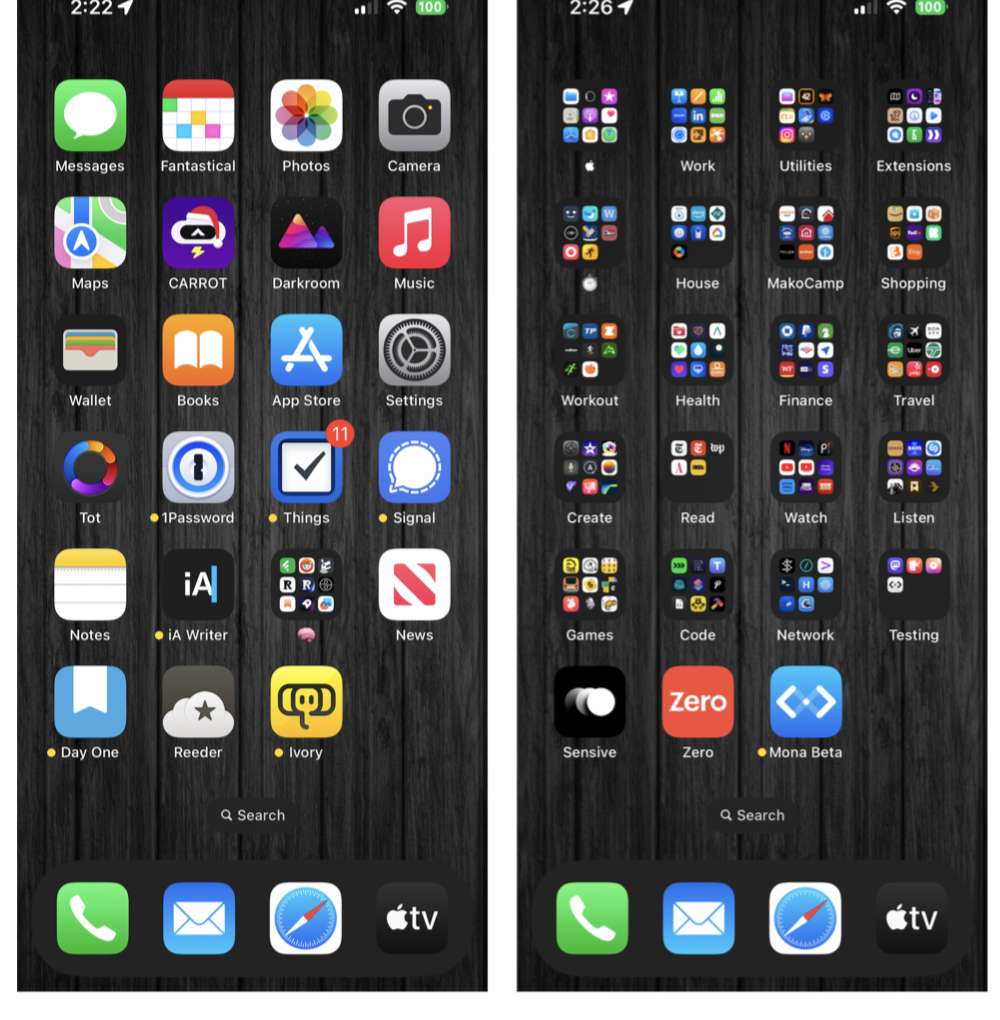
iPad 2022
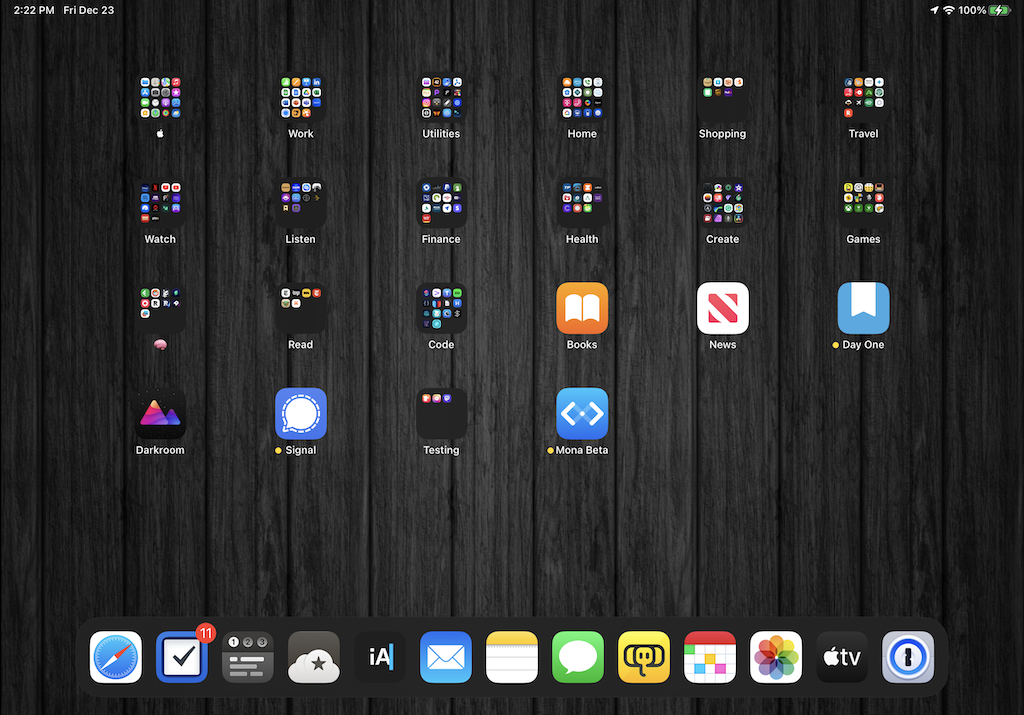
And.. that’s a wrap. See you in 2023. Be well and if you enjoyed this - you can always feed the habit by buying me a coffee ☕️. ✌🏻
